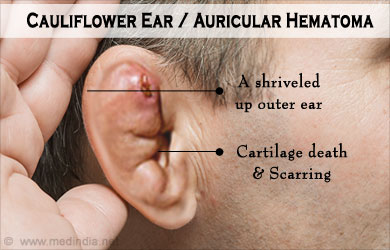The term cauliflower ear refers to a deformity of the ear caused by blunt trauma or other injury, such as what may occur during a boxing or wrestling match. Left untreated, the injury leads to a blockage that prevents blood flow and damages tissue. This results in a bumpy or lumpy appearance on part of the ear,similar to a cauliflower. Early treatment can help prevent permanent deformity.
Fortunately, the types of injuries that cause cauliflower ear are often preventable by wearing the right type of protective head gear.

Causes of Cauliflower Ear
The most common cause of cauliflower ear is a hit to the ear — or repeated hits to the ear — that leads to hematomas, or small collections of bloodthat clot and block the flow of blood and nutrients. These can also occur when skin is pulled away from cartilage, the semi-rigid tissue that gives the ear its shape.
Usually, cauliflower ear is related to sports injuries, but not always. Any trauma to the ear can cause it. Cauliflower ear can even be the result of an infection in the ear lobe.
When blood flow is blocked, the affected cartilage may die and, without the supportive tissue, fold in on itself. Scar tissue may form, contributing to a swollen and deformed look. Over time, the effects may become more prominent, and they may be permanent. The good news is that cauliflower ear can usually be prevented, even after such an injury occurs.
Risk Factors for Cauliflower Ear
Cauliflower ear occurs most frequently in people who participate in close-contact sports, such as wrestling or boxing. In wrestling, for instance, trauma can result from opponents’ heads rubbing or hitting one another during matches or from contact with the wrestling mat. Cauliflower ear is also common among rugby players and people who practice martial arts. People who participate in these activities are at higher risk than others. Protective head gear has long been commonplace in these sports.
But these injuries can also occur in non-athletes. They may be the result of accidents or physical altercations. They also can be a complication of “high” piercings in the upper area of the ear, through the cartilage, if the piercing becomes infected.
Symptoms of Cauliflower Ear
The initial symptoms of the types of injuries that lead to cauliflower ear are similar to the symptoms one might experience from blunt trauma elsewhere in the body. You may have swelling, and the area may be red or bruised. So it’s important not to shrug off such symptoms if you have received a blow, or multiple blows, to the ear. Prompt treatment can prevent the development of cauliflower ear. But it must be performed before the tissue is compromised by lack of blood flow.
Treatment of Cauliflower Ear
If you experience an injury that causes a blockage in the tissues of your ear, there’s still a chance you can avoid developing cauliflower ear. The goal of treatment is to ease the blockage so that blood can again flow to the affected tissues.
A doctor can accomplish this by making a small incision and draining accumulating blood or removing a clot and preventing further bleeding. He or she may need to reconnect tissues using stitches and apply a special bandage to put pressure on the area. This pressure dressing may need to stay in place for several days to a week. The site will require monitoring for signs of infection or signs that additional treatment may be needed. Your doctor may also prescribe antibiotics.

Post a comment